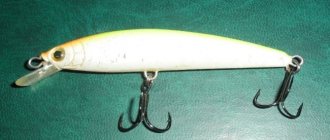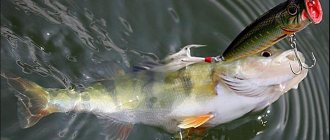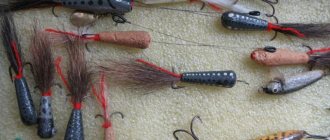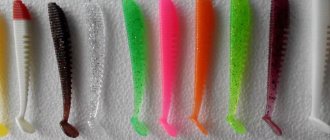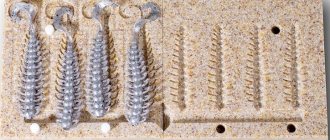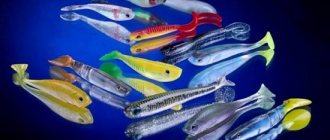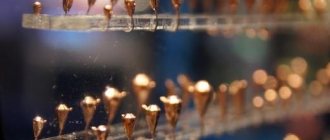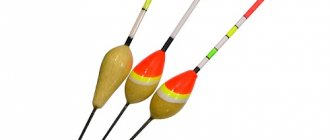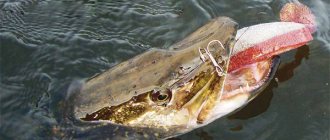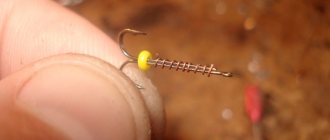The secret of successful fishing lies in knowing the lifestyle characteristics of a particular aquatic inhabitant. The colors of pike bait should take into account the behavior of the fish in its natural environment: preferences depending on the spawning season, time of year, size and habits of typical prey, etc.
The color of the chosen bait can tell on the result of fishing
Baits for spring
In spring, pike feed on small fish and fry. In this regard, spring wobblers should be small in size and neutrally buoyant. Wiring also cannot be very fast, because... the predator is not yet very active after the cold season.
The color of silicone for pike fishing before spawning should be neutral. The fish is extremely cautious, so experiments with bait colors are more likely to scare it away than to bring a successful catch. Neutral shades similar to scales work well.
June and July are often busy periods for fishermen with small catches. This is due to the fact that during the spawning period the pike generally refuses to eat.
However, if this solution does not bring a catch, you can try brighter options. Again, you shouldn’t choose jerking or acceleration - the fish simply won’t keep up with the prey. But in late spring, immediately after spawning, the colors of silicone baits for pike become more varied: the fish begin their favorite season with fishermen - the post-spawning glutton, and the predator is ready to swallow everything indiscriminately.
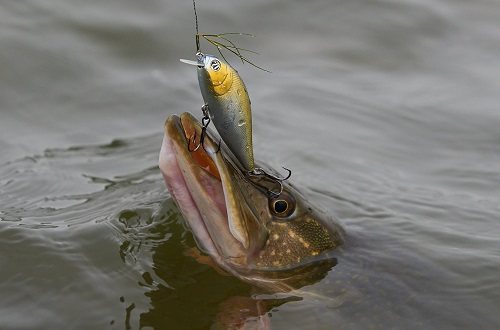
For fishing in spring, you should not use bright baits.
Colors of silicone lures
Date: January 23, 2021 | 197
The color of the silicone bait is one of the factors when choosing a specific rubber. One can argue for a long time about the importance of silicone color. Some people attach great importance to the choice of color, while others look almost dismissively at this parameter. The truth, as usual, is somewhere in the middle. Much in this matter depends on the fishing conditions, the breed, and the degree of activity of the fish. Well, since it is impossible to claim objectivity on such a controversial topic, in this article I will express my subjective opinion on various colors and features in their use.
The color of the edible and the color of ordinary silicone baits, which were at the height of fashion some 7-10 years ago, are in practice completely different palettes. Both the shape of rubber and their colors are evolving strongly and rapidly, multiplying and growing. For those interested in the topic of jigs and soft baits, these changes are very interesting.
It would seem that the color spectrum has been known for a very long time. But, at first, the manufacturers did not have enough desire or imagination. The usual set of colors for soft baits at that time was quite scarce. The favorites were: white, pearlescent, yellow, several shades of green, brown. Red and black also appeared, but somewhat less. Some colors had glitter, some without.
Here, for example, are the colors that were in use when I was just mastering jigs; I catch pike and perch with vibrating tails and twisters.
Then, two-color and three-color options appeared. For example, these.

Well, then it was time to eat. Yes, and the second wave of various ordinary silicone has arrived. And then it splashed from a rainbow fountain.
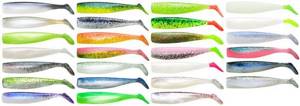
I see neither the point nor the possibility of describing each color. There are unique colors and shades from some manufacturers. Many colors are repeated. I will devote the rest of the article to analyzing a number of my favorite colors and the most popular ones, describing the conditions in which they work best for me.
Machine oil color . This is one of the most popular flowers among jigs, micro jigs and edibles. Brown, with a reddish or greenish tint. Sometimes sparkles are added to the material, shading the bait with one or another tint.

All forms of silicone baits are absolutely good in this color. Vibrating tails, twisters and medium-sized slugs in the color of machine oil are very good at catching pike perch. Various fishtails in this color are, for many anglers, including me, one of the best colors for perch.
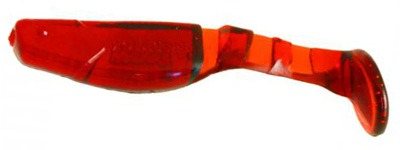
Various peaceful fish also react very positively to baits in this color.
I especially like micro-twisters, small vibrating tails, micro worms and slugs in this color. Machine oil has a greenish tint, which is almost the natural color for crayfish. So, for this form of edible, “motor oil” is very appropriate.
Basically I use this color from the moment the water becomes sufficiently clear until the end of the season.
Shades of brown . Machine oil borders very closely with a wider palette of shades of brown.
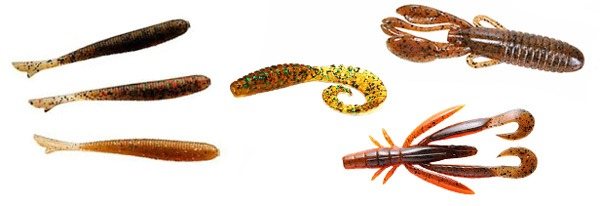
These are also very catchy and popular colors. I use them somewhat less frequently than “machine oil,” but they have also proven themselves to be extremely good. It’s not bad when the material is translucent, with the addition of multi-colored sparkles.
In particular, the edibles in the Ebimiso Sp color palette from Reins work well for me.
LOX color . The famous color LOX from Reins is one of the shades of purple. Despite all the strangeness and seeming unnaturalness of this color, it works brilliantly in a pond. Many copies have been broken regarding the best colors of silicone lures. But, in my opinion, and the opinion of many, some of the best are: “Loch” and “Machine oil”. I don’t even see the point in trying to put one of them at the top. Sometimes one works better, sometimes the other.

Also, Raines has another variation of this color “Pink Lox”, with a pinkish appearance. Didn't notice much difference.
Don't think that only Reins has such a killer color. Many companies use very similar colors in their palettes. There are analogues for Lucky John, Bait Breath, Crazy Fish, and many others. In general, I often go by color by eye rather than by code. There are many manufacturers. Each has its own codes and color names. Keeping all this in mind is more difficult than simply navigating by visual perception.
Speaking of the best colors of edibles. Either “machine oil”, “Lox”, ash-black, or “olive” - all are dark, all are similar in color to benthic organisms, crustaceans, spiders, leeches, crayfish, etc. And the hue, tint, greenish, purple - only emphasizes the similarity with the living prototype. This, as I see it, is the secret of the catchiness of these colors.
White color . White color, light, both on its own and in combinations, is a color close to natural, to natural. In vibrotails, slugs, fish - this is an imitation of light, silvery colored fry. In the case of twisters, worms - imitation of whitish earthworms, larvae, maggots.
So this color is also very popular. I caught a lot of pike in lakes and bays using a light jig with small and medium vibrating tails in this color.
Also, white silicone baits are clearly visible in muddy water. So, this color should be used in the spring, on rivers. In muddy water, not only pike and perch respond well to white bait, but also chub, asp, and ide.
Pearlescent color . Mother of pearl is also very similar to white in nature and application. But, there were cases when catching the same pike, when mother of pearl greatly exceeded the usual milky white in the number of bites. Apparently the glare from this color, especially when applied to active baits, vibrotails and twisters, as well as fish, is very appropriate.
Translucent, light . Various highly transparent colors are especially good in clear, clean water. Many benthic organisms, especially in the early stages of development, have not yet acquired a chitinous shell, and look translucent, with translucent organs. So, the success of silicone in such colors is quite understandable.

There are colors of this type with a greater or lesser degree of transparency, with or without colored sparkles in the structure.
Ash color . In my personal rating, the translucent black color with glitter is one of the favorites, on a level with “machine oil” and “sucker”. In fact, these three colors make up my personal TOP 3 when choosing the color of an edible.
This color is well represented in the Blue Gill color from Keitech and Kosadaka DS, and many manufacturers also have analogues.
Black color . Pure black, for some reason, is noticeably inferior to the previous color option. But small twisters and large thick leech worms in this color are very good.
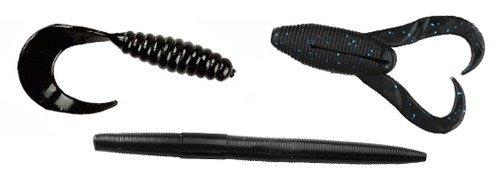
I would say that black lures especially make sense when it comes to contrast. A dark spot against the background of algae, against the background of a light sandy bottom, against the background of the sky - this provokes fish very well. So, I recommend placing absolutely black baits, first of all, in light, clear water.
Next, let's go through the main colors of the rainbow.
Red color . Despite all the similarity in color with bloodworms, worms, fish fins, despite all the stereotypes that a predator loves red because it is the color of blood, I have a frankly unimportant relationship with red silicone baits.
This food works well at shallow depths, up to 1-1.5 m, in clear water. Apparently, at greater depths, red is seen as dark gray, and there is no longer any color resemblance to the prey. So, I can recommend this color for shallow fishing.
There are red phosphorescent baits that accumulate light. They can be successfully used for deep-sea jigging. However, at depth nothing remains of their redness - only a glow...
Pink color . Pink lures are very popular for coastal fishing in the sea (rock fishing), as well as for trout fishing in clear lakes and streams.

Sometimes this color of bait works very well for pike perch and pike perch. Despite all the glamor, these colors worked much better for me than red.
Pink is an excellent provocateur color, a representative of bright colors. Accordingly, in addition to clear water, this coloring can be successfully used in muddy water and on a passive predator that needs to be stirred up and shocked. In particular, such a bright unnatural color can help with this.
Orange. Carrot . The carrot sometimes, very infrequently, but it works and shoots. I'm not a big fan of this colorway. But, as second-tier baits, I have carrot-colored silicones and from time to time they help out.
Yellow. Lemon . In the era when pike perch and pike were caught using classic jigs and vibrating tails, yellow was one of the most lethal and catchy colors. And even now, if you fish with an ordinary jig using the old classics, then it remains so.
However, this color does not appear so often in modern edible silicone baits. And, it seems to me, yellow, for some reason, turns out to be one of the colors that has most lost its position and popularity. I don’t know, maybe it’s not so for someone. But this is exactly the picture I get. If I fish with active baits, vibrating tails, sometimes with twisters, then the yellow color is in use. When it comes to other forms of edibles, its place is very insignificant. A strange phenomenon.
Salad color . About the same story as with yellow. This color works very actively in vibrotails and twisters for active pike and pike perch, especially in not very clear water.
In the format of worms, slugs, crayfish, somehow these colors didn’t work for me.
Dull green . Green with a haze of white and yellow. This was the color of the first vibrotails on which I started catching pike, mastering jig fishing. And now, when it comes to catching catfish, I also take baits of this color with me and use them.
Edibles in these colors, in my opinion, are somewhat more interesting than just yellow or bright green. But, again, this is just my subjective opinion.
Green color . Shades of green are a very good and popular color. Of course, in heavily overgrown places, near algae, this color is lost. But, on a relatively clean bottom, on rocks, on sand, on clay, among snags, it is quite possible. In some cases, dark green colors are in no way inferior to other dark classics.

I would especially note the olive tint of the baits. And also, green colors, additionally saturated with sparkles.
Shades of blue . To be honest, I still haven’t warmed up to the blue colors of silicone... But when jigging pike perch at extremely great depths, it makes sense to try such colors.
Purple color . Well, in fact, purple and its shades are the closest “relatives” of the already mentioned color “LOX”. So it works well!
Combined coloring pages . Many silicone baits have multi-colored colors designed to emphasize realism, to almost photographically recreate the living food object that this or that bait imitates. Of course, these colors are most appropriate when imitating a fish. Less commonly, for shrimp and crustaceans.
Contrasting color combinations . Also, very often there are combined colors based on two or three colors. For example, this is a contrasting coloring of the back and abdomen of a silicone fish, vibrotail, slug.
A red spot, or other contrasting spot in the head or tail of the bait is a good technique. And here the point is not so much in the redness of the spot, but in its contrast. It turns out that the attack point for the fish is highlighted in color. It is for this purpose that many fish imitations have living three-dimensional eyes.
Presence of sparkles . It cannot be said unequivocally that the presence of glitter increases catchability. But the presence of sparkles of one color or another in the material, of course, enriches the palette.
Phosphorescent colors . There are baits in which the material has light accumulating properties. As a rule, these are white, yellow, green or red baits. At great depths, in the dark, they glow.
And now, a little physics. Different parts of the light spectrum, different colors, behave differently in water with increasing depth. This is due to the refraction of a ray of light on the surface of the water. And the thicker the layer of water, the greater the depth at the observation point, the fewer visible colors remain.
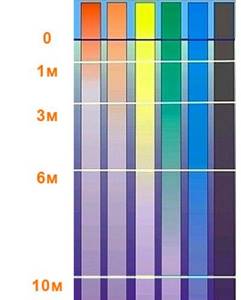
The red one disappears first. So, red baits lose all meaning deeper than 1.5-2m. And in muddy, dark water, even higher, about 1 m. Further, at the level of 3 meters, orange disappears. At 4-5m - yellow. Green works up to 6-7m. Blue and purple also work at depths that are almost limiting for jigs, up to 10m and a little more.
So, in addition to the recommendations for choosing silicone colors discussed in the material, you can correlate your choice with the depths at which you plan to fish.
Share with your friends:
Categories: Edible · Tags: Lures, Edible, Color
Lures for the summer
The color of bait a pike likes in the summer depends on the stage of its breeding cycle. After spawning, the fish becomes more measured and shows an interest in large prey with aggressive behavior.
When choosing bait, you should take into account the factor of weather conditions. In clear weather, the fish must be provoked to attack. Lures in bright blue shades work best with this. In shallow water, silver or reddish-orange colors are also suitable, as is a regular metal spoon. In cloudy weather conditions, gold-colored baits are a win-win option. It should be taken into account that in deep or muddy water, bright, acidic and fluorescent shades are more preferable.
Thus, in the summer you can safely choose rich colors of silicone lures for pike, and also go fishing with jerky wiring that imitates the aggressive behavior of the predator.

Colored baits are suitable for summer fishing
The best colors for pike fishing
It is impossible 
As a rule, every experienced angler who regularly goes pike fishing has his own preferred color options . At the same time, the opinions of spinning anglers about their favorite pike colors greatly .
But general recommendations on choosing bait colors for this fish can still be given. When assembling a collection for pike fishing, you should pay special attention to the following colors :
- naturalistic colors - silver, bronze and perch colors;
- provoking, acidic colors - green, yellow, orange;
- Red color;
- black color.
When compiling a collection of lures for pike , it is worth buying two types of models - naturalistic and provocative colors. They can be alternated while fishing to determine which option the fish prefers on that particular day. Silver and bronze baits imitate various types of fish , and perch colors should be used primarily in those reservoirs where this fish is the main food item for pike .
Provocative colors do not resemble potential prey of a predator. But they greatly irritate the pike, provoking it to bite , and often turn out to be the most catchy .
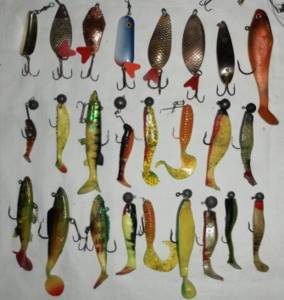
Black baits are not often , and they cannot be found in every store. Many people don’t even know that they exist and turn out to be catchy when hunting for pike. However, spinning anglers periodically find themselves in situations respond best to this color.
In some cases, black baits save anglers from complete loss of bite . Therefore, if possible, it is worth adding several of these models to the collection and using them for fishing when standard colors work poorly or do not produce results at all.
When fishing for pike, it is first of all important to find the fish, select a bait suitable for the fishing conditions and correctly present it to the predator. But color also matters, and you should have a good arsenal of models of different colors , and on a pond, if there are no bites experiment to choose the most catchy option. This approach will reduce the likelihood of being left with a bad catch or no catch at all to a minimum.
Lures for autumn
In autumn, wobblers should be selected according to weather conditions and the characteristics of a particular body of water. On sunny days with high transparency, you can resort to classic colors: black and red. Few people know about the existence of black baits, but this shade can also bring a catch, especially in reservoirs with a sandy bottom.
If the beginning of autumn (September-October) turns out to be sunny, baits of natural colors are also suitable. With the onset of November, when the weather is mostly cloudy, it is better to choose bright colors to indicate bait.
In autumn, the fish still retains mobility, although as the water temperature drops, it gradually moves deeper. This must be taken into account by consistently changing baits from less to brighter, as well as selecting buoyancy, which will gradually increase the vertical fishing area.
You need to be aware that when the fish goes under water more than 5 meters, the color of the bait loses its meaning. Only the smell, bait and adequate casting depth become significant.
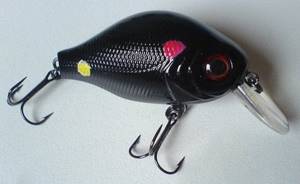
In autumn you can experiment with black baits
Lures for the winter
In winter, pike goes closer to the bottom and becomes inactive. It is becoming increasingly difficult to catch it, because practically no light penetrates through the thickness of the cold water. The best colors for pike are fluorescent, they have high catchability in dark conditions. It is better to choose a slow and calm retrieve for a spinning rod, since the predator prefers to conserve energy in the cold season.
If fishing takes place under ice, it is generally irrational to think about choosing the color of the bait. Even if the bait glows, lazy fish are difficult to attract with visual stimuli during this period.
The choice of odorous bait or feeding is important. In low light conditions, it is much easier to interest a predator with scent rather than color. It should also be remembered that if pike perch bites on the bait, then you should look for another place to catch pike. These fish compete for territory and are not found within the same area of the reservoir.
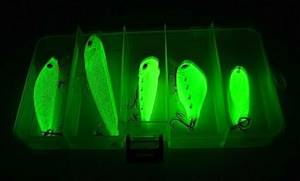
Glowing baits are suitable for winter fishing
Conclusion
It is impossible to say for sure what color of wobbler the pike likes. It is impossible to even say for sure how she perceives the colored world. The above are just some recommendations that have proven their effectiveness in the experience of many fishermen, as well as in scientifically conducted experiments. In addition to the color of the bait, it is worth considering other fishing parameters: buoyancy, type of fishing line, depth of the reservoir, type of bait, etc. With the help of these recommendations and samples directly at the fishing site, as well as observations, you can understand how to get a catch.
Lures for catching pike in the fall will be discussed in the video:
Choosing a color for the fishing conditions
There is no consensus
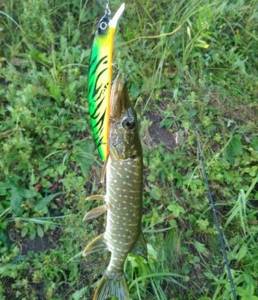
Others carefully select the type of bait for the fishing conditions and try to make it as attractive as possible during fishing, not paying attention to the color. Let's figure out who is right and who is wrong and find out what color pike likes.
In reality, coloring affects the size of the catch , and attention .
First of all, take into account the general rules for selecting colors for pike, which relevant when catching predators:
- on bright sunny days, models with dull colors work better;
- in cloudy weather, bright ;
- dark- models are suitable for fishing in dark water ;
- when the water is cloudy, preference should be given to bright colors, including acidic ones .
Bright lures and spinners that reflect light work great on cloudy days and in murky water, as they are most visible to predators. For sunny weather and for illuminated shallow water in clear water, they are much worse , since flashy colors and sparkling metal in such conditions cause rejection .
Important .
It must be borne in mind that color plays a role primarily when fishing in clear water and shallow water. At depths greater than 5 meters it no longer matters. When fishing with jigs, preference should be given to baits that do not merge with the bottom . So, dark colors work on sandy soil. On a muddy bottom, in turn, the best results can be achieved with light ones .

